Unveiling the Great White Shark: Apex Predator of the Ocean
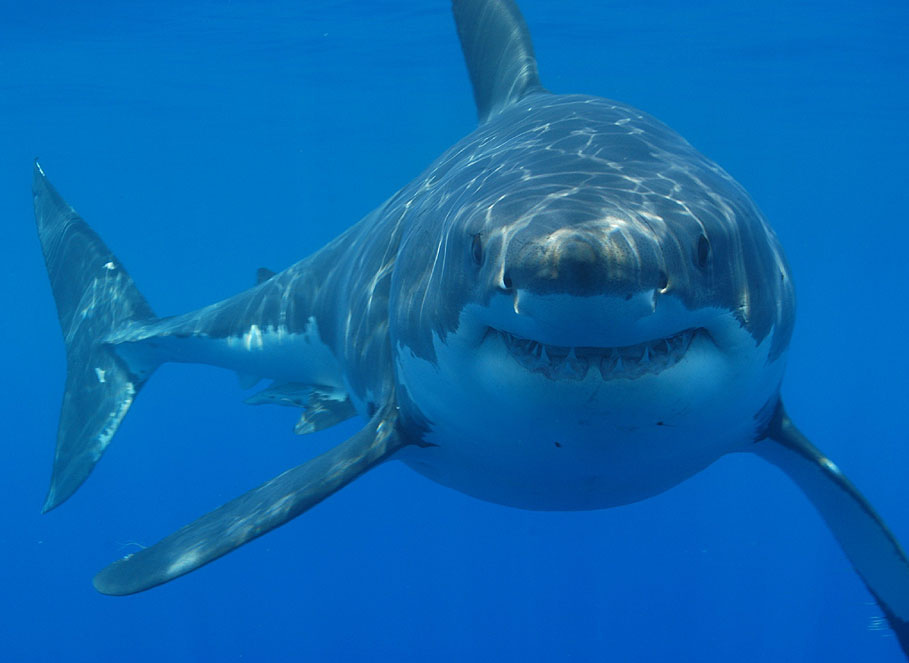 Welcome to the fascinating world of the Great White Shark! Also known as the White Shark, White Pointer, Man-eater, and White Death. This iconic creature has captured our imagination for decades with its fearsome reputation and mysterious allure. With its impressive size, sharp teeth, and powerful presence, it’s no wonder why this predator is often the subject of films, documentaries, and even horror stories. But there is so much more to the Great White Shark than just its scary reputation. These magnificent creatures are incredibly intelligent and have a vital role in the marine ecosystem. Join me on this journey as we explore the many facets of the Great White Shark and shed light on why this fascinating creature has become such a fixture in our society’s imagination.
Welcome to the fascinating world of the Great White Shark! Also known as the White Shark, White Pointer, Man-eater, and White Death. This iconic creature has captured our imagination for decades with its fearsome reputation and mysterious allure. With its impressive size, sharp teeth, and powerful presence, it’s no wonder why this predator is often the subject of films, documentaries, and even horror stories. But there is so much more to the Great White Shark than just its scary reputation. These magnificent creatures are incredibly intelligent and have a vital role in the marine ecosystem. Join me on this journey as we explore the many facets of the Great White Shark and shed light on why this fascinating creature has become such a fixture in our society’s imagination.
Taxonomy and Classification
Have you ever wondered how scientists classify animals? Well, one fascinating example is the classification of the Great White Shark. Taxonomy, the science of classifying organisms, has placed the Great White Shark in the Kingdom Animalia, the Phylum Chordata, the Class Chondrichthyes, and the Order Lamniformes. These classifications describe the shark’s overall anatomy, including its cartilaginous skeleton and the presence of a notochord. But what makes the Great White Shark stand out is its family classification, Lamnidae, which includes some of the largest predatory sharks in the ocean. Understanding the taxonomy and classification of these magnificent creatures is essential for not only scientific research and documentation but also for comprehending their role in the ecosystem.
Taxonomy Breakdown
Kingdom: Animalia
- The Great White Shark belongs to the Kingdom Animalia, which encompasses all multicellular organisms that are eukaryotic, meaning their cells have a nucleus. This classification includes a vast array of animals, ranging from insects to mammals.
Phylum: Chordata
- Within the animal kingdom, the Great White Shark falls under the Phylum Chordata. This phylum comprises animals with a notochord, a flexible rod-like structure that provides support during their early development. Chordates also possess a dorsal nerve cord and pharyngeal slits at some point in their life cycle.
Class: Chondrichthyes
- The Great White Shark is classified under the Class Chondrichthyes, which consists of cartilaginous fish. Unlike bony fish, cartilaginous fish have skeletons made primarily of cartilage instead of bone. This class includes sharks, rays, and chimeras.
Order: Lamniformes
- Within the class Chondrichthyes, the Great White Shark belongs to the Order Lamniformes. This order comprises several species of large, predatory sharks, known for their streamlined bodies and powerful jaws. Lamniformes also include other notable sharks such as the Mako Shark and the thresher sharks.
Family: Lamnidae
- The Great White Shark is further classified into the Family Lamnidae. This family includes some of the most formidable and iconic predatory sharks in the ocean. Along with the Great White Shark, it encompasses other species like the Shortfin Mako Shark, the Longfin Mako Shark, the Salmon Shark, and the Porbeagle Shark. Sharks in the family Lamnidae are renowned for their speed, strength, and hunting abilities.
Physical Characteristics
When it comes to impressive physical features, the Great White Shark certainly takes the prize. From its powerful jaws and rows of sharp, serrated teeth, to its massive size and sleek, conical snout, and torpedo-shaped body, this apex predator is truly a feat of nature. But perhaps what makes the Great White most recognizable is its iconic dorsal fin, which slices through the water with effortless grace. And while they may look intimidating, Great Whites are simply magnificent creatures, honed by millions of years of evolution to perfectly thrive in their ocean habitat. So while encountering one may be a heart-pumping experience, it’s hard not to be struck by the awe-inspiring beauty of the Great White Shark.
Habitat and Distribution
Great White Sharks are among the most captivating and awe-inspiring creatures in the ocean. To those curious about their habitats and distribution, here’s everything you need to know: these magnificent predators are present in almost every ocean across the globe, including the Gulf of Mexico and the Caribbean, but have a preference for temperatures between 50 and 80 degrees Fahrenheit, such as those of South Africa and California. While they tend to inhabit coastal areas while juveniles, as they get older white sharks tend to spit their time between coastal and pelagic waters (offshore waters). By gaining a deeper understanding of the Great White Shark’s habitat and distribution, we can strive to protect this invaluable species and uphold its important ecological role.
Feeding Habits and Diet
 As apex predators of the ocean, Great White Sharks have unique feeding behavior and dietary preferences. These remarkable creatures primarily feed on marine mammals, such as seals and sea lions, because of their high-fat content which fuels the great whites’ energy needs, but also consumes smaller fish and sea turtles when the opportunities present themselves. During hunting, they use their keen sense of smell to hunt seals, their preferred prey, before launching an explosive attack from below. Interestingly, like many sharks Great Whites “sample biting” is often used on their prey before deciding whether to continue with the attack or not. This feeding behavior, coupled with their incredible power and agility, make them a fearsome predator. Despite their power and perceived fierceness, Great Whites are essential to the ecosystem and play a critical role in maintaining the balance of marine life in our oceans.
As apex predators of the ocean, Great White Sharks have unique feeding behavior and dietary preferences. These remarkable creatures primarily feed on marine mammals, such as seals and sea lions, because of their high-fat content which fuels the great whites’ energy needs, but also consumes smaller fish and sea turtles when the opportunities present themselves. During hunting, they use their keen sense of smell to hunt seals, their preferred prey, before launching an explosive attack from below. Interestingly, like many sharks Great Whites “sample biting” is often used on their prey before deciding whether to continue with the attack or not. This feeding behavior, coupled with their incredible power and agility, make them a fearsome predator. Despite their power and perceived fierceness, Great Whites are essential to the ecosystem and play a critical role in maintaining the balance of marine life in our oceans.
Hunting Strategies
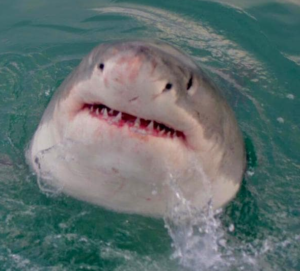 When it comes to hunting, the Great White Shark truly stands out among the world’s most powerful predators. With razor-sharp teeth and lightning-fast reflexes, this apex predator employs a range of techniques to capture its prey. One impressive strategy utilized by these creatures is known as “spy-hopping,” during which the shark sticks its head above the surface for a better view of its surroundings to track prey and adjust its hunting strategy accordingly. Another remarkable technique they use is called “breaching.” In this marvel of an event, the shark will breach the water at the surface at a speed of over 20 mph, launching itself above the water
When it comes to hunting, the Great White Shark truly stands out among the world’s most powerful predators. With razor-sharp teeth and lightning-fast reflexes, this apex predator employs a range of techniques to capture its prey. One impressive strategy utilized by these creatures is known as “spy-hopping,” during which the shark sticks its head above the surface for a better view of its surroundings to track prey and adjust its hunting strategy accordingly. Another remarkable technique they use is called “breaching.” In this marvel of an event, the shark will breach the water at the surface at a speed of over 20 mph, launching itself above the water 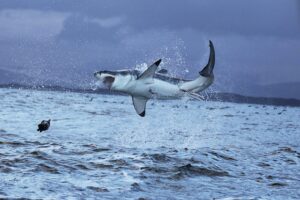
entirely to nab its prey, usually larger prey such as a seal. The Great White Shark’s mastery of these predatory tactics demonstrates how they are one of the most feared and respected ocean predators out there. These skills, combined with their highly evolved sense of smell and electroreceptors, make them the perfect marine hunters even in nature’s harshest environments.
Migration Patterns
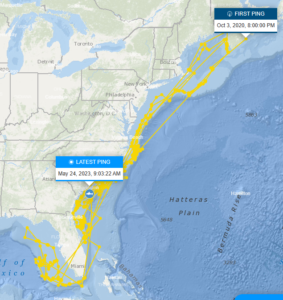 The Great White Shark is one of the most fascinating creatures, and its migratory behavior is just as intriguing. Researchers have spent decades studying the migration patterns of these magnificent predators, using technologies such as satellite tags and acoustic transmitters. Great Whites have been known to travel thousands of miles in a single year, crossing entire oceans and visiting different continents in the process. Scientists believe that these migrations are influenced by a variety of factors, including food availability and breeding cycles. Tracking these sharks as they move through the world’s oceans has shed light on their behavior and helped to dispel some of the myths and misconceptions that have surrounded them for years. While there is still much we don’t know about the Great White Shark, the insights we’ve gained from studying their migration patterns have been invaluable.
The Great White Shark is one of the most fascinating creatures, and its migratory behavior is just as intriguing. Researchers have spent decades studying the migration patterns of these magnificent predators, using technologies such as satellite tags and acoustic transmitters. Great Whites have been known to travel thousands of miles in a single year, crossing entire oceans and visiting different continents in the process. Scientists believe that these migrations are influenced by a variety of factors, including food availability and breeding cycles. Tracking these sharks as they move through the world’s oceans has shed light on their behavior and helped to dispel some of the myths and misconceptions that have surrounded them for years. While there is still much we don’t know about the Great White Shark, the insights we’ve gained from studying their migration patterns have been invaluable.
Reproduction and Life Cycle
The great white shark is an elegant and mysterious creature that we often associate with gruesome attacks. But there’s so much more to these apex predators than their aggressive reputation. Did you know that they have a unique reproductive strategy that sets them apart from other shark species? Great White sharks are ovoviviparous which means that instead of laying eggs like most sharks, the eggs hatch within the female then shortly thereafter the great white gives birth to live offspring. As for their life cycle, it’s an intriguing and complex process that involves different stages of growth and development. It begins when a female great white reaches sexual maturity at around 14 to 16 years of age and ends when she dies a natural death. Along the way, these fascinating creatures navigate challenges and obstacles that only make them more resilient and awe-inspiring.
Interactions with Humans
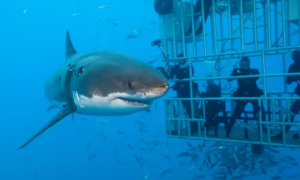 The Great White Shark has long been a fascination to humans. Over the years, notable encounters between these majestic predators and humans have gained global attention. The mystery, danger, and intrigue surrounding these interactions have created a deep fascination within us. While many may be quick to paint Great White Sharks as mindless killing machines, the truth is more complex. Great Whites are intelligent, curious, and highly adaptable animals that play a vital role in maintaining the delicate balance of marine ecosystems. By examining historical and modern encounters, we can understand the depth of these creatures and the importance of respecting their space and habitats. As we continue to learn more about the fascinating behavior of the Great White Shark, we have an opportunity to grow in our appreciation and understanding of these powerful creatures.
The Great White Shark has long been a fascination to humans. Over the years, notable encounters between these majestic predators and humans have gained global attention. The mystery, danger, and intrigue surrounding these interactions have created a deep fascination within us. While many may be quick to paint Great White Sharks as mindless killing machines, the truth is more complex. Great Whites are intelligent, curious, and highly adaptable animals that play a vital role in maintaining the delicate balance of marine ecosystems. By examining historical and modern encounters, we can understand the depth of these creatures and the importance of respecting their space and habitats. As we continue to learn more about the fascinating behavior of the Great White Shark, we have an opportunity to grow in our appreciation and understanding of these powerful creatures.
Myths and Misconceptions
When it comes to the Great White Shark, there are a lot of myths and misconceptions out there, mainly due to sensationalized reporting and films. These majestic creatures have been vilified in popular culture, but the reality is that they play an important role in their ecosystem. For starters, Great White Sharks are not mindless killing machines. In fact, they are quite intelligent and are known to be curious about their surroundings. They also don’t actively seek out human flesh to feast on. In most cases, when a shark attacks a person, it’s because the shark mistook them for prey such as a seal. As for their size, while it’s true that Great Whites can grow to upwards of 20 feet they are not the largest shark in the ocean or the largest predator. We must dispel these myths and misconceptions surrounding the Great White Shark so that we can understand and appreciate them for what they truly are.
Shark Tourism and Conservation
As ocean enthusiasts, it’s no surprise that we’re passionate about shark tourism and conservation. The more we learn about these fascinating creatures, the more we appreciate their importance to our planet’s delicate ecosystem. By supporting responsible and sustainable shark tourism practices, we can offer a unique opportunity for people to observe these animals up close and personal, leading to better understanding and appreciation. Additionally, such tours can help fund conservation efforts, which are crucial in protecting these magnificent animals from overfishing, habitat destruction, and other human-related threats. Whether you’re a seasoned diver or just a curious traveler, we hope to inspire you to join us in promoting awareness and conservation of sharks.
Shark Attacks and Safety Measures
Shark attacks are a rare occurrence, but they are in the back of the mind for most beachgoers. There are a variety of risk factors that can increase your likelihood of being attacked, such as swimming in murky water or being in an area where sharks are known to frequently reside due to natural prey being in the area. However, there are also precautionary measures that can be taken to protect yourself. Some beaches employ shark spotters or lifeguards to monitor the water and alert beachgoers if a shark is near. Additionally, swimming in groups and avoiding wearing shiny objects or high-contrast clothing can also deter sharks. Remember, always be aware of your surroundings and take the necessary steps to ensure your safety while enjoying the beautiful ocean waters.
Threats and Challenges
As one of the ocean’s apex predators, the Great White Shark has always commanded a sense of power and awe among those drawn to the ocean’s depths. However, it is now facing an unprecedented threat- the decline of its population. The Great White Shark’s survival is being challenged by a range of factors, from overfishing and bycatch to the effects of climate change. It’s a sobering thought that our fascination with these majestic creatures may also have contributed to their decline. But fret not because conservation initiatives have been put in place to save our beloved sea monsters! Researchers, marine biologists, and enthusiasts alike have been working hard to address these challenges and raise awareness of the importance of protecting these amazing creatures. The outlook for the future of the Great White Shark is therefore a positive one, with both individuals and organizations stepping up to ensure their survival. Despite the threats they face, the tenacity of these beautiful creatures gives us hope that their populations may once again thrive.
Summary
In conclusion, the great white shark is truly one of the most fascinating creatures in the ocean. The taxonomy and classification of this apex predator reveal its unique position at the top of the food chain. Its physical characteristics, such as its size and powerful jaws, make it a formidable force that commands respect. The habitat and distribution of the great white shark span the globe, from the coastal waters of California to the remote islands of the Pacific.
Feeding habits and diet are other areas where the great white shark stands out. Its hunting strategies are incredibly complex and sophisticated, often involving surprise attacks and clever maneuvering. The migration patterns of these sharks are also something to behold, covering thousands of miles across open waters.
When it comes to reproduction and the life cycle of the great white shark, there is still much to learn. However, with the correct protections in place white shark populations can increase since we do know that these animals can live for several decades and produce litters of up to 14 pups.
Unfortunately, the interactions between humans and great white sharks have not always been positive. Myths and misconceptions about these creatures are common, leading to fear and misunderstanding. However, shark tourism and conservation efforts are helping to shift perceptions and promote a greater understanding of these animals.
Shark attacks and safety measures are also a concern, but it’s important to remember that these incidents are still rare. By following common-sense safety guidelines, such as avoiding swimming in areas known to be frequented by sharks, we can greatly reduce the risks.
Finally, we must acknowledge the threats and challenges faced by great white sharks and other shark species. Habitat destruction, overfishing, and climate are all factors that are putting these animals at risk. As stewards of the ocean, it’s up to us to protect these magnificent creatures for future generations to enjoy.
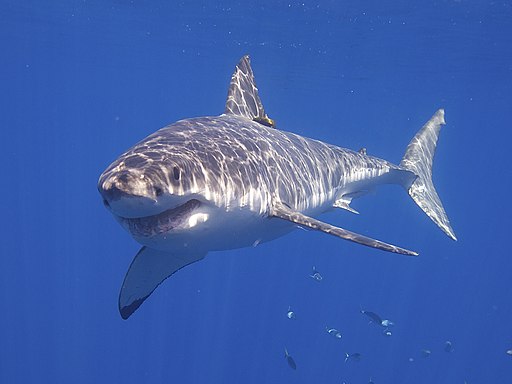
FAQs (Frequently Asked Questions)
Q: Are Great White Sharks really as dangerous as they are portrayed in movies?
A: While great white sharks are powerful predators, they are not typically a threat to humans. Human-shark interactions are extremely rare, and most incidents are cases of mistaken identity. Great whites primarily feed on marine animals, such as seals and sea lions.
Q: How fast can a Great White Shark swim?
A: Great white sharks are impressive swimmers and can reach speeds of around 25 to 35 miles per hour (40 to 56 kilometers per hour) during bursts of speed.
Q: Do Great White Sharks have any natural predators?
A: As apex predators, Great White Sharks really only have 2 natural predators. The first is a larger Great White Shark and the second is orcas (killer whales).
Q: Can Great White Sharks survive in captivity?
A: Great white sharks have proven challenging to maintain in captivity for long periods. Due to their large size and specialized needs, they have not been successfully kept in captivity for extended periods, making long-term survival in captivity difficult.
Q: What is the average lifespan of a Great White Shark?
A: Most scientists believe the average lifespan of a great white shark is estimated to be around 30 to 40 years. However, their lifespan can vary depending on factors such as diet, health, and environmental conditions of the surrounding water.
Q: How do researchers track and study Great White Sharks?
A: Researchers use various methods to track and study great white sharks. These include satellite tags, acoustic tags, underwater cameras, and observations from boats and aircraft. These techniques help gather data on their movements, behavior, and population dynamics.
Q: Are Great White Sharks endangered?
A: Great white sharks are currently listed as a vulnerable species. They face threats such as overfishing, accidental capture in fishing gear, and habitat degradation. Conservation efforts are important to protect and sustain juvenile white sharks and their populations.
Q: What should you do if you encounter a Great White Shark?
A: If you encounter a great white shark while swimming or diving, it is important to remain calm and avoid aggressive, erratic movements or excessive splashing. Maintain eye contact, slowly and steadily move away from the shark, and exit the water as calmly as possible.
Q: How many species of Great White Sharks exist?
A: There is one recognized species of great white shark: Carcharodon carcharias. However, some regional populations may exhibit slight genetic variations.
Q: How large can a Great White Shark grow?
A: Great white sharks can grow to impressive sizes. On average, adult females typically reach lengths of 15 to 20 feet (4.5 to 6 meters), while adult males are generally smaller, ranging from 11 to 13 feet (3.5 to 4 meters).
• Great White Sharks can be found in every ocean, preferring cooler waters below 80°F such as those around South Africa and California.
• They are typically found near the coast but have been sighted in open ocean regions too.
• Contrary to popular belief, they don’t prey on humans; instead they feed on seals, sea lions, and other marine life.
• Learning about their habitat and distribution helps us protect them and their importance to the ocean ecosystem.
The great white is a popular shark that is widely talked about, this shark is amazing and is one of those sea creatures that rules the sea. It’s amazing but not surprising how marine biologists have taken an interest in this shark, a highly respected shark that stands alone when it comes to other sharks.
Thanks for the comment. Great White Sharks are awesome creatures, very majestic swimming through the water.